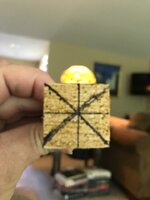I assume you want to cut a 45 the length of a pen blank(5" or so) in a 3/4" or 1" blank. You can not do it. It will not equal a 45 because you do not have enough material. You can cut the blank in half (corner to corner) What tools do you have?? Can do it on either bandsaw or tablesaw. The kerf on tablesaw is greater so more material lost if that means anything but it would be a cleaner cut. Need a sled Many different ways to make sleds. Use miter slots, use miter gauge, or use fence, Not sure how easy this is to explain but cut a kerf in the sled (whatever method you choose.) Place doublesided tape over the slit. Now lay the blank corner to corner on the center of the kerf. If I am understanding what you want to do.
In my photo this is a jig for cutting 45 degrees in a pen blank. It can be easily used for doing what I think you want to do. As I said lay doublesided tape over kerf and lay the blank corner to corner on center of kerf. Make sure there is tape under the entire blank to keep it secured. Not much room for clamps so I would hold the blank down with a push stick. This can be adapted for a bandsaw as well. Or just freehand it on a scrollsaw or bandsaw. Again if I am not understanding then this is all moot








